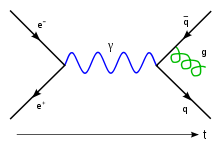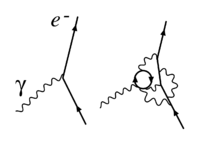- Coupling constant
-
For the Murray-von Neumann coupling constant, see von Neumann algebra.For the coupling constant in NMR spectroscopy, see NMR spectroscopy and/or Proton NMR.
In physics, a coupling constant, usually denoted g, is a number that determines the strength of an interaction. Usually the Lagrangian or the Hamiltonian of a system can be separated into a kinetic part and an interaction part. The coupling constant determines the strength of the interaction part with respect to the kinetic part, or between two sectors of the interaction part. For example, the electric charge of a particle is a coupling constant.
A coupling constant plays an important role in dynamics. For example, one often sets up hierarchies of approximation based on the importance of various coupling constants. In the motion of a large lump of magnetized iron, the magnetic forces are more important than the gravitational forces because of the relative magnitudes of the coupling constants. However, in classical mechanics one usually makes these decisions directly by comparing forces.
Contents
Fine-structure constant
The coupling constant comes into its own in a quantum field theory. A special role is played in relativistic quantum theories by coupling constants which are dimensionless, i.e., are pure numbers. For example, the fine-structure constant,
(where e is the charge of an electron, ε0 is the permittivity of free space,
 is the reduced Planck constant and c is the speed of light) is such a dimensionless coupling constant that determines the strength of the electromagnetic force on an electron.
is the reduced Planck constant and c is the speed of light) is such a dimensionless coupling constant that determines the strength of the electromagnetic force on an electron.Gauge coupling
In a non-Abelian gauge theory, the gauge coupling parameter, g, appears in the Lagrangian as
(where G is the gauge field tensor) in some conventions. In another widely used convention, G is rescaled so that the coefficient of the kinetic term is 1/4 and g appears in the covariant derivative. This should be understood to be similar to a dimensionless version of the electric charge defined as
Weak and strong coupling
In a quantum field theory with a dimensionless coupling constant g, if g ≪ 1 (g is much smaller than one) then the theory is said to be weakly coupled. In this case it is well described by an expansion in powers of g, called perturbation theory. If the coupling constant is of order one or larger, the theory is said to be strongly coupled. An example of the latter is the hadronic theory of strong interactions (which is why it is called strong in the first place). In such a case non-perturbative methods have to be used to investigate the theory.
Running coupling
One can probe a quantum field theory at short times or distances by changing the wavelength or momentum, k of the probe one uses. With a high frequency, i.e., short time probe, one sees virtual particles taking part in every process. The reason this can happen, seemingly violating the conservation of energy is the uncertainty relation
which allows such violations at short times. The previous remark only applies to some formulations of quantum field theory, in particular, canonical quantization in the interaction picture. In other formulations, the same event is described by "virtual" particles going off the mass shell. Such processes renormalize the coupling and make it dependent on the energy scale, μ at which one observes the coupling. The dependence of a coupling g(μ) on the energy-scale is known as running of the coupling. The theory of the running of couplings is known as the renormalization group.
Beta functions
Main article: Beta function (physics)In quantum field theory, a beta function β(g) encodes the running of a coupling parameter, g. It is defined by the relation:
where μ is the energy scale of the given physical process. If the beta functions of a quantum field theory vanish, then the theory is scale-invariant.
The coupling parameters of a quantum field theory can flow even if the corresponding classical field theory is scale-invariant. In this case, the non-zero beta function tells us that the classical scale-invariance is anomalous.
QED and the Landau pole
If a beta function is positive, the corresponding coupling increases with increasing energy. An example is quantum electrodynamics (QED), where one finds by using perturbation theory that the beta function is positive. In particular, at low energies, α ≈ 1/137, whereas at the scale of the Z boson, about 90 GeV, one measures α ≈ 1/127.
Moreover, the perturbative beta function tells us that the coupling continues to increase, and QED becomes strongly coupled at high energy. In fact the coupling apparently becomes infinite at some finite energy. This phenomenon was first noted by Lev Landau, and is called the Landau pole. However, one cannot expect the perturbative beta function to give accurate results at strong coupling, and so it is likely that the Landau pole is an artifact of applying perturbation theory in a situation where it is no longer valid. The true scaling behaviour of α at large energies is not known.
QCD and asymptotic freedom
In non-Abelian gauge theories, the beta function can be negative, as first found by Frank Wilczek, David Politzer and David Gross. An example of this is the beta function for Quantum Chromodynamics (QCD), and as a result the QCD coupling decreases at high energies.
Furthermore, the coupling decreases logarithmically, a phenomenon known as asymptotic freedom (the discovery of which was awarded with the Nobel Prize in Physics in 2004). The coupling decreases approximately as
where β0 is a constant computed by Wilczek, Gross and Politzer.
Conversely, the coupling increases with decreasing energy. This means that the coupling becomes large at low energies, and one can no longer rely on perturbation theory.
QCD scale
In quantum chromodynamics (QCD), the quantity Λ is called the QCD scale. The value is
This value is to be used at a scale above the bottom quark mass of about 5 GeV. The meaning of ΛMS is given in the article on dimensional transmutation.
The proton-to-electron mass ratio is primarily determined by the QCD scale.
String theory
A remarkably different situation exists in string theory. Each perturbative description of string theory depends on a string coupling constant. However, in the case of string theory, these coupling constants are not pre-determined, adjustable, or universal parameters; rather they are dynamical scalar fields that can depend on the position in space and time and whose values are determined dynamically.
Quantum field theory 
History of... BackgroundSymmetriesIncomplete theoriesScientistsJamal Nazrul Islam • Adler • Bethe • Bogoliubov • Callan • Candlin • Coleman • DeWitt • Dirac • Dyson • Fermi • Feynman • Fierz • Fröhlich • Gell-Mann • Goldstone • Gross • 't Hooft • Jackiw • Klein • Landau • Lee • Lehmann • Majorana • Nambu • Parisi • Polyakov • Salam • Schwinger • Skyrme • Stueckelberg • Symanzik • Tomonaga • Veltman • Weinberg • Weisskopf • Wilson • Witten • Yang • Yukawa • Hoodbhoy • Zimmermann • Zinn-JustinSee also
- Quantum field theory, especially quantum electrodynamics and quantum chromodynamics
- Canonical quantization, renormalization and dimensional regularization
- fine structure constant
- gravitational coupling constant
References
- An introduction to quantum field theory, by M.E.Peskin and H.D.Schroeder, ISBN 0-201-50397-2
External links
-
Wikimedia Foundation. 2010.








